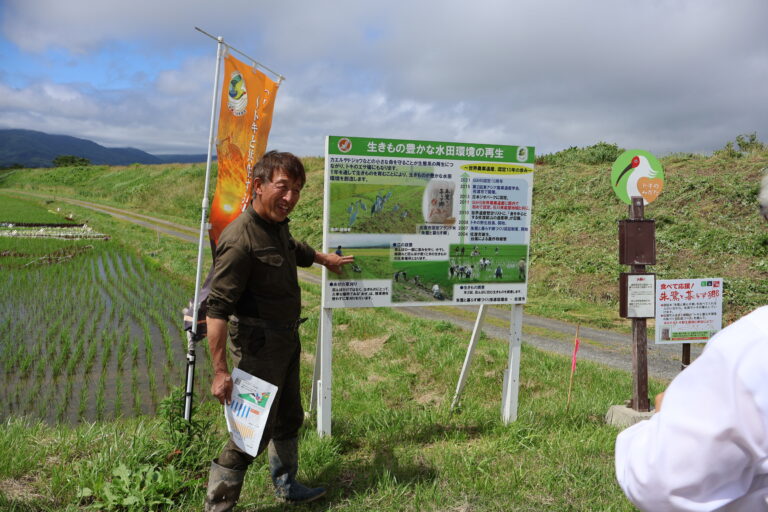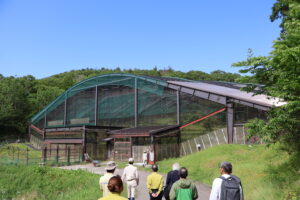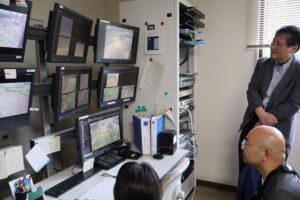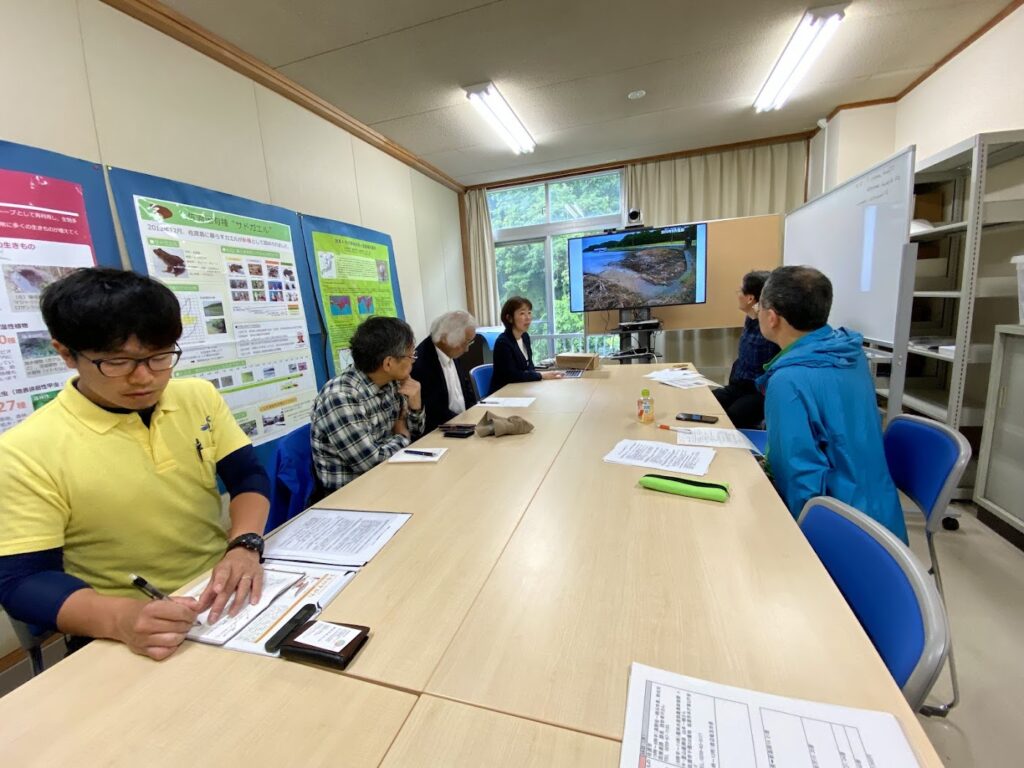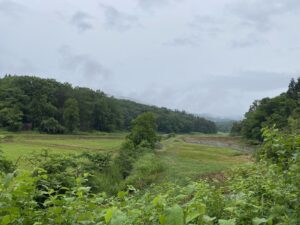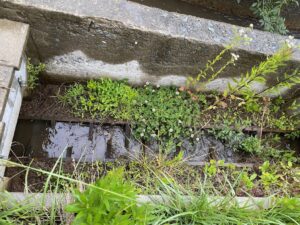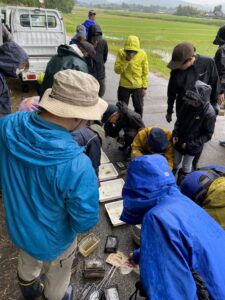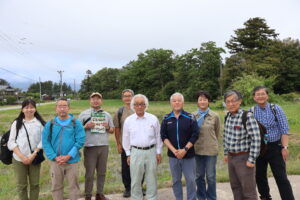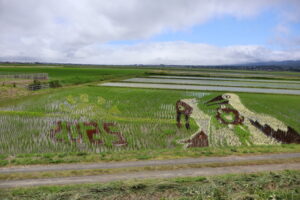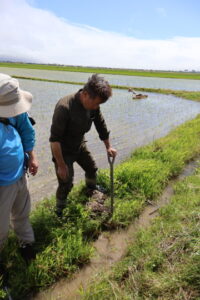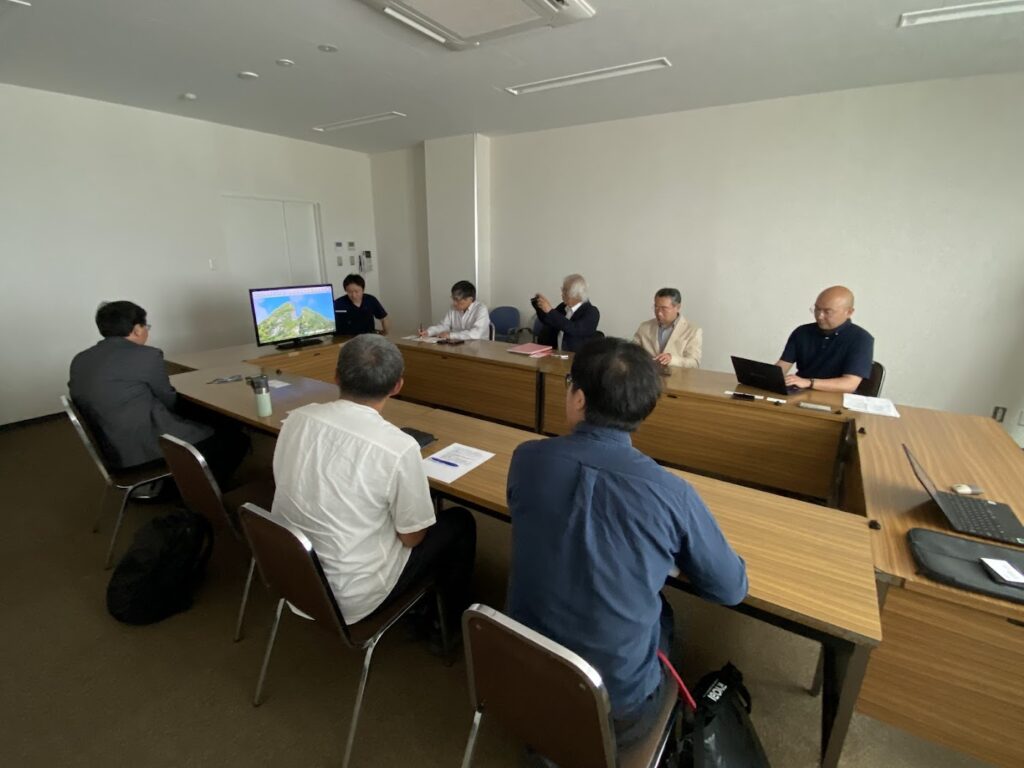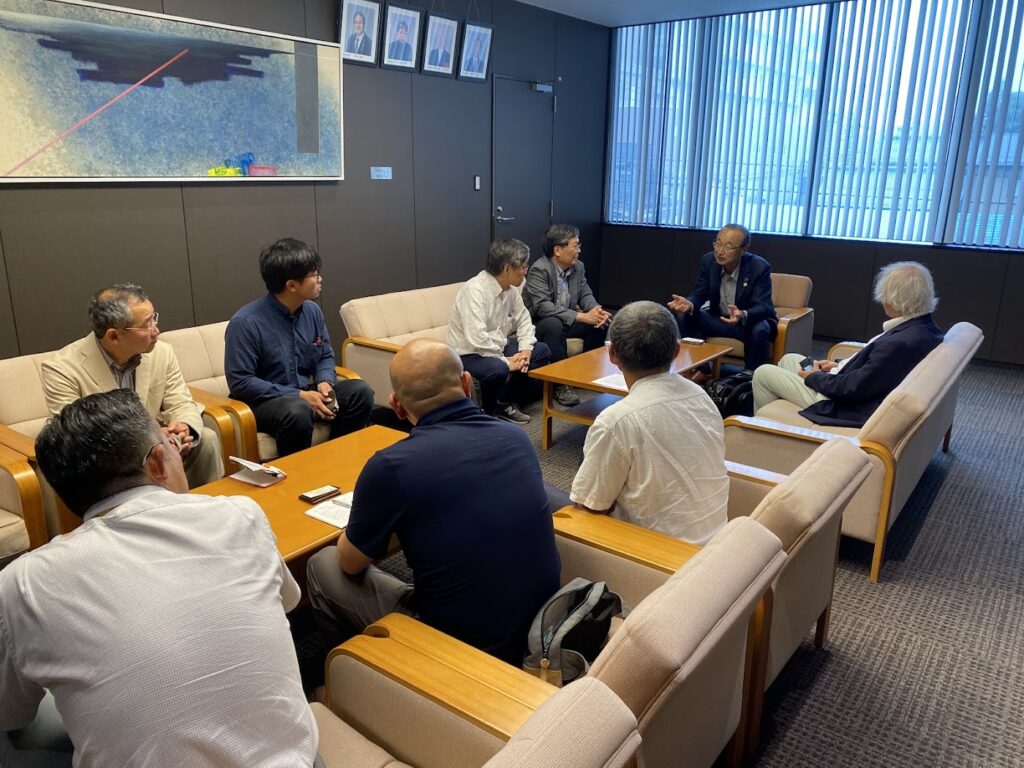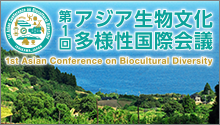Preparations for releasing the crested ibis on the Noto Peninsula in 2026 have been underway since before the earthquake. Following the earthquake and the heavy rain of 2024, the release of these birds is expected to symbolize the region’s recovery of satoyama and satoumi. However, since the situation in Noto still remains difficult, it is important that the project be carried out as a sustainable initiative that meets the wishes and current conditions of the local communities.
The Noto GIAHS (Global Important Agricultural Heritage Systems) Biodiversity Working Group has been developing a mechanism for citizen-participatory surveys of living creatures and implementing them with local residents. From June 13 to 16, 2025, eight members of the working group visited Sado to learn about citizen-participatory surveys of living creatures and efforts to release ibises that have been conducted on the island for many years.
The release of crested ibises began in Sado in 2008, and the population now exceeds 500. Additionally, the “Toki to kurasu sato” certification program, which promotes rice production friendly to living creatures, as well as surveys of living creatures in rice paddies, conducted in collaboration with farmers and children, are implemented as ongoing community-rooted activities. We visited Sado to learn about its efforts and apply them to future sustainable biodiversity conservation and local revitalization in Noto.
Learning from the Sado Ranger Office, Ministry of the Environment, and Sado Japanese Crested Ibis Conservation Center, Niigata Prefecture
Mr. Takashi Kitahashi and Ms. Kanako Ikikame from the Ministry of the Environment, as well as Mr. Takashi Oya and Ms. Kiyoko Inoue from Niigata Prefecture, shared the story of breeding and training of crested ibises prior to their release. At the pre-release training facility, we learned how to acclimate the birds to people and agricultural machinery, as well as the measures taken against predators. We were also shown the remote monitoring system for the breeding cages. It was impressive to see the Ministry of the Environment and Niigata Prefecture work closely together in the same facility which reaffirmed the importance of collaboration among the national government, local governments, universities, and the private sector.
Discussion with Prof. Mitsuyo Toyoda
Professor Mitsuyo Toyoda from Sado Island Center for Ecological Sustainability Office for Community Design, Niigata University, introduced the efforts made on Sado to build consensus among residents and support their activities. Although some fishers from Lake Kamo where the Tenno River flows into, expressed their opposition regarding the nature restoration of the river, through neutral facilitation and careful discussions, they have reached a consensus and are now working together to create reed beds at Lake Kamo and provide environmental education for children. Their story of building a good relationship through consensus building was impressive. We realized the importance of taking a sociological approach, like Professor Toyoda’s, to carry out nature restoration efforts, such as returning the crested ibis to the wild. This approach connects various stakeholders, such as the government and citizens, and carefully picks up the voices of local residents.
Visit to the Tenno River Nature Restoration Site
However, both Sado and Noto are facing labor shortage. There is an urgent need to establish a long-term system for maintaining and managing these natural environments. In depopulated areas, we felt it was important to consider sustainable methods of nature restoration taking into account the maintenance and management needs.
Institute for Sado Ikimonogatari : Learning from Creature Survey Efforts
First, the Institute for Sado Ikimonogatari arranged for us to participate in one of the twice-yearly (June and August) surveys of creatures, which is one of the requirements for “Toki to kurasu sato” certified rice. We participated in the June survey by the Nagaune Producer’s Association, Agricultural Cooperative which has produced certified rice since the inception of the certification system. Despite the drizzle, many residents, including children, gathered to search for living creatures. We easily found loaches, tadpoles, frogs, dragonfly larvae, and many other creatures. From a distance, crested ibises searching for food could be seen in the neighboring rice paddy.
The next day, we interviewed Mr. Katsumi Oi and Dr. Asami Oishi from the institute about their work. They showed us their original illustrated field guide “Illustrated field guide of creatures in Sado paddies” and shared with us their challenges and the living creature surveys they have been conducting with farmers and children. Although they have not been able to make full use of the data they collected on the creatures, they mentioned that they are valuing the experience of getting to know the creatures more than the data itself. They also shared that the institute is facing challenges to continue its activities due to budget cuts and other factors. We were reminded of the need for sustainable organizational management and the difficulties involved.
Learning from Saito Farm’s Practices
Under the guidance of Mr. Shinichiro Saito, we visited the “Toki to kurasu sato” certified rice paddies. We learned about the various efforts they have made to create rice paddies for the crested ibis. These efforts include paddies where rice paddy art has been created for the past nine years, as well as naturally cultivated rice paddies, farmed without any fertilizer or pesticides, where fishways and ditches have been created, and where weeding is being experimented with using a duck robot.
We learn that the “Fuyumizu tambo” (winter-flooded rice paddies), which originated on the Pacific Ocean side of Japan, are not suited to the environment of Sado on the Japan Seaside, which has high levels of precipitation. He mentioned that it is better to keep the water level low, just enough for it to accumulate in the wheel tracks. This benefits both the quality of the rice and the crested ibis, which has short legs. Mr. Saito’s trial-and-error experience will be very helpful for Noto, which has a similar climate to Sado.
Mr. Saito said, “Efforts will not last long if we only provide economic incentives to farmers.” He emphasized the importance of fostering farmers’ interest in living creatures and crested ibises.
Discussion with Sado City Representative
First, we spoke with Mr. Koichiro Takano, former mayor, and Mr. Takayuki Nishimaki, who was in charge of branding and sales channel development for ibis rice at the time. They told us about the background of the decision to release the ibis on Sado and their rice branding efforts. We learnt that the decision to release the crested ibis was made during a time when Sado rice was severely damaged by a heat wave caused by a typhoon. This event also coincided with a significant turning point in the merging of municipalities. It was impressed by what they said about the importance of cooperating with JA (the Japan Agricultural Cooperatives) to realize branded rice in that situation.
Next, Mr. Nagao Nakamura, Mr. Kazuki Yamamoto, and Ms. Mako Igarashi from the Agricultural Policy Division of the Agriculture, Forestry and Fisheries Department introduced the status of certified rice distribution and their collaboration with Coop Deli. They also introduced educational activities for children through the “Sado Kids Living Creatures Survey Team” conducted in cooperation with the Institute for Sado Ikimonogatari. Also, they introduced the efforts being made to provide certified rice in the school lunches.
More than 30 children participate in the “Sado Kids Living Creatures Survey Team” every year. They also introduced a case of a child who participated in this program became a city officer and now actively working in the community. This drew attention to the program as an effort to nurture the next generation and foster a sense of community attachment. Additionally, with regard to securing human resources to serve as instructors for the survey of living creatures, they mentioned about the instructor system implemented more than 10 years ago. Such a system seems effective in developing human resources, as those who participated in it are still active as instructors.
Lastly, we interviewed Mayor Ryugo Watanabe. He introduced the long history of efforts to release the crested ibis and branding of the certified rice. Sado Koshihikari rice is already a popular brand and is in high demand. For this reason, “Toki to kurasu sato” certified rice, which further incorporates farming methods that nurture living creatures, is sometimes sold under the name Sado Koshihikari to meet the demand for the latter. Therefore, in these cases, farmers are not fully compensated for their additional efforts. For this reason, Sado City is now promoting the sale of the certified rice through hometown tax payments. The mayor also emphasized the importance of engaging in careful dialogue and collaborating with a variety of stakeholders, including the JA and farmers.
During this visit to Sado, we experienced the wide range of efforts to return the crested ibis to the wild, as well as the passion of those who support these efforts. We believe that their experience on Sado is very important to us in Noto as we move forward on our journey to release the birds, coexist with nature, and maintain agriculture in the region. As we make progress towards recovery, we hope to work together with local people to think about a better relationship between people and nature.
This study visit was partially supported by the Taisei Corporation Public Trust of Funds for Natural and Historic Environment.


